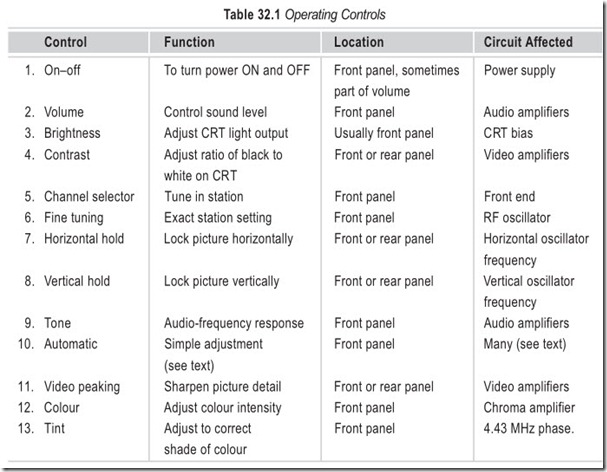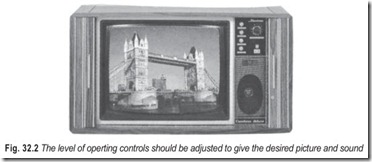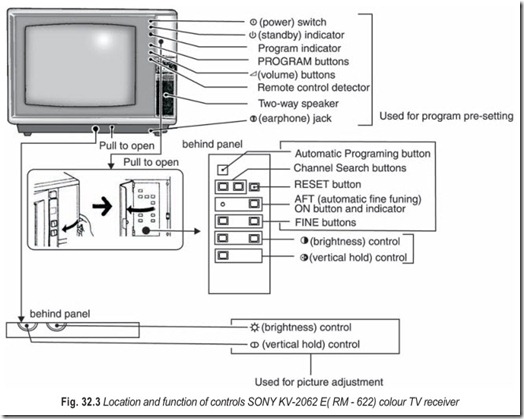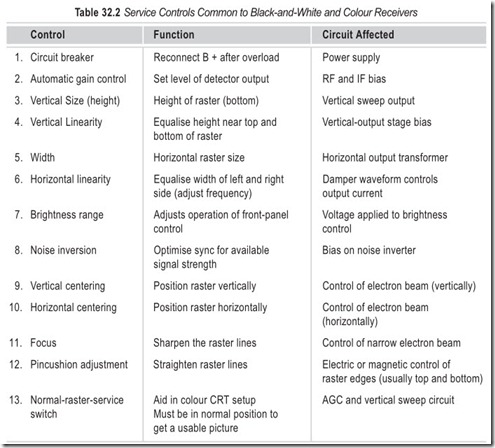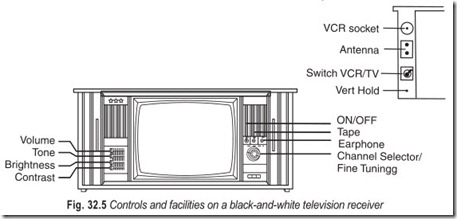TELEVISION CONTROLS
There are three types of controls or adjustments in a TV receiver. In the first group come those controls which are accessible to and used by the viewer. These are called user or customer controls. The second group consists of those controls which the service technician adjusts while setting up the receiver in the customer’s house. These service controls are usually located on the rear apron of the receiver. The third group includes the alignment adjustments for tuning the frequency response and bandwidth of RF, IF, sound IF and colour circuits.
Proper alignment of these adjustments, which requires specialised knowledge and equipment, is usually done only in the service shop.
Many colour receivers include automatic circuitry. This circuitry is usually activated by pushing a special button that is often designed to light up when it is engaged. These include automatic fine tuning, automatic tint, and preset controls for colour, tint, brightness and contrast. The automatic button permits the less critical viewer to obtain a usable picture quality.
COMMON OPERATING CONTROLS OF BLACK-AND-WHITE AND COLOUR RECEIVERS
To become familiar with the common controls,first turn the colour or chroma control fully counter clockwise, switching it off. This would eliminate all colour information from the screen. The adjustments now would be the same as of a black-and-white receiver.
The television viewer must be able to adjust the operating conditions of the receiver. The names of most user controls describe what they do and this simplifies understanding their adjustment. Table 32.1 lists the operating controls a viewer may have to adjust in order to set up the television receiver for proper operation.
The operating controls are set up in the following way. The ON-OFF switch is turned to the ON position and the receiver is allowed enough time to warm up. The automatic control is set to off. The volume control is adjusted for the presence of some sound. The brightness control is adjusted to show a raster on the picture tube, Fig. 32.1. The channel selector is then switched ON to bring in the desired station and the fine tuning is adjusted to bring in the best picture and sound. In colour receivers, the setting of the fine tuning is critical. Many receivers now include automatic fine tuning (AFT) to eliminate this problem. If multiple lines or an unsychronised picture appears, the vertical hold is adjusted to
stop any up and down motion. Similarly, the horizontal hold is adjusted to eliminate horizontal or diagonal bars. The level of the operating controls such as brightness and contrast should then be readjusted to give the desired picture and sound. The initial and final touch-up adjustments may be made in any sequence.
In some colour receivers, there are additional user controls to adjust picture and sound. These may include tone control and video peaking. The tone control varies the sound frequency response, emphasising either high (treble) or low (bass) frequencies. The video peaking control emphasises or reduces the high- frequency response of the video circuits in the receiver. For strong signals, emphasised high-frequency results in crisp sharp pictures. For weak or fringe signals, maximum high-frequency response, within the range of the video peaking control, reduces noise in the picture.
COMMON SERVICE CONTROLS FOR BLACK-AND-WHITE AND COLOUR RECEIVERS
Television service technicians must adjust many different types of television receiver controls. Understanding the circuits and the functions of each control will help technicians to make proper adjustments. Since you are not expected to adjust these controls properly or to be familiar with receiver circuitry at this point. Table 32.2 is to be referred for information on the effects of service controls. This table lists most service controls with a general description of their function and of the circuits affected.
A number of precautions should be observed at all times while working on a television receiver with the power ON. The high-voltage cage should always be closed and any shield about the regulator must be in place. The high-voltage lead from the cage to the cathode ray tube (CRT) must be well insulated and dressed out of the way, since voltages of 30,000 V are now quite common in colour receivers. Most black- and-white receivers have about 20,000 V for the sets using large picture tubes and about 10,000 V for smaller ones.
The picture tube is highly evacuated and requires careful handling. Accidentally hitting the picture tube with a tool, scratching it, dropping it, or any sharp contact with it may cause it to implode. Such an implosion causes glass fragments to fly around with great force and can cause considerable damage and physical injury. Many modern picture tubes have some form of integral implosion protection. This can be an epoxy attached face plate, a metal shell attached near the front, a tension band near the front of the tube, etc. None of these systems must ever be tampered with or removed and such a CRT must never be replaced with an unprotected tube.
COLOUR OPERATING CONTROLS
In addition to the controls normally found in a black-and-white television receiver (see Fig. 32.5), the colour receiver has two operating controls for the colour rendition of the picture. The colour control, sometimes called chroma or saturation control adjusts the amount of colour information in the scene. With the control turned fully counter-clockwise, the picture turns black-and-white. As the control is rotated clockwise the picture goes from delicately tinted shades, through stronger pastel shades, to bright colours and finally to colour overload manifest as an iridescent appearance and streaking.
The second control is the tint or hue control (see Fig. 32.3). This control changes the actual hue or colour of the scene.
The most readily available reference colour on the screen is the flesh colour. In most receivers, turning the tint control counter-clockwise from its centre position will make the flesh tones magenta and turning clockwise from the centre will make the flesh tones green. To adjust for the proper flesh tones, the colour control must be set for near normal colour levels. Flesh colour is not the only reference colour the viewer may use. In many cases, the colour of some well known, advertised product or package can be used to adjust the tint control correctly. Red is generally the easiest colour for this purpose.
EXERCISES
Descriptive Questions
1. Explain the difference between operating controls and service controls.
2. Briefly explain the operating controls common to black-and-white and colour receivers.
3. Explain the service controls common to black-and-white and colour receivers.
4. How will you operate a colour television receiver?

